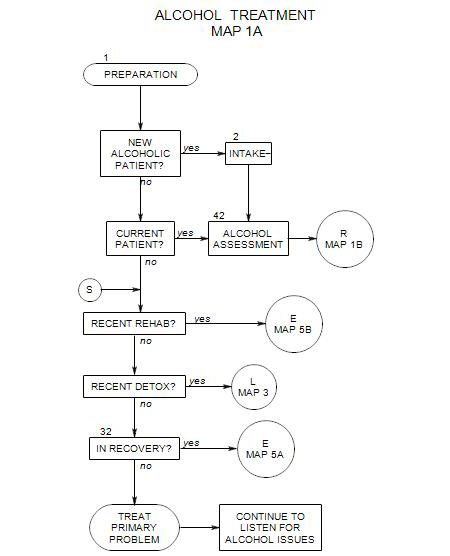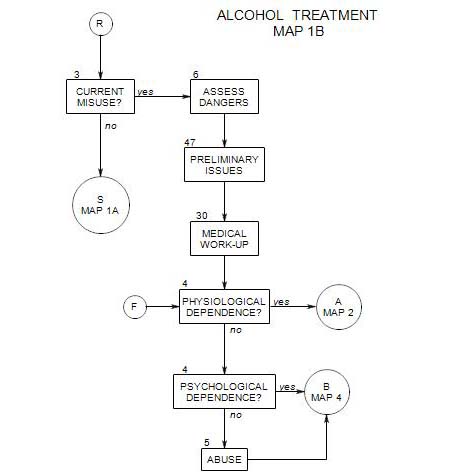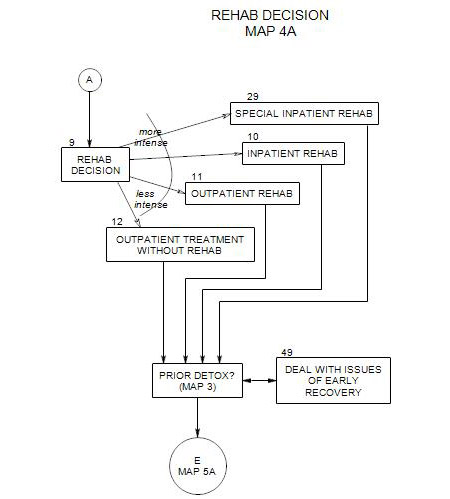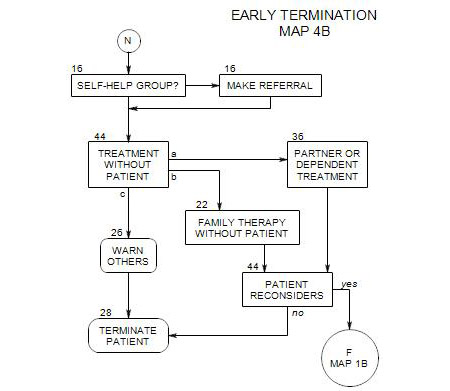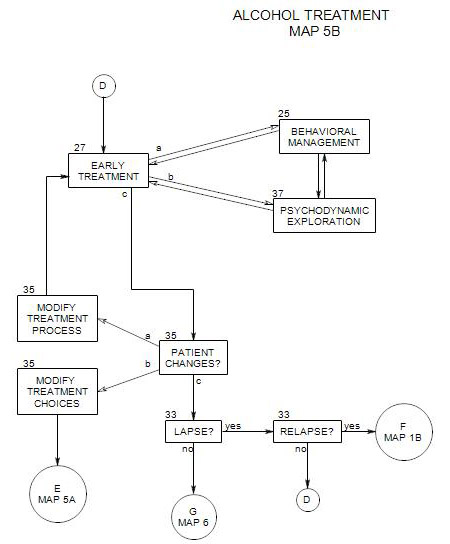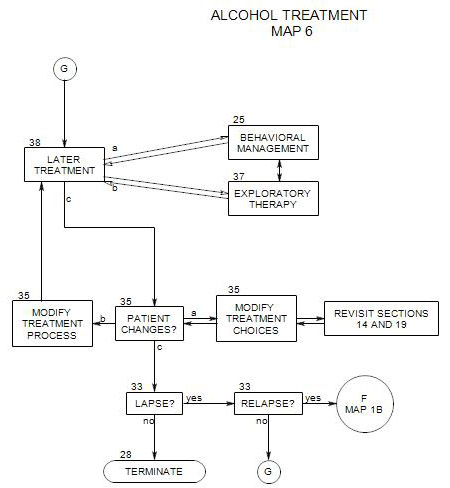20. TREATMENT CHOICE INFORMATION
- This section is preparation for Section 14 and Section 19, in which the form of treatment is selected, and the following sections on treatment process. It also assumes that prior information has been collected in Sections 3, 42 and 47. For treatment process information, see Section 24.
Choice of treatment format involves a collaboration between therapist and patient. This section addresses some of the information that needs to be gathered in order to make effective choices. The problem is a double one: how much treatment to provide and what kind of treatment is most likely to be helpful to the patient. The treatment most likely to be helpful is a function of the issues that the patient wants to address and the disruptiveness of the patient’s alcohol use.
A number of issues bear on the choice of treatments for a patient. These are listed as subheadings for the present section:
- the treatment options available to the patient.
- the patient’s stage of change relative to alcohol use and willingness to accept help.
- the patient’s expectations about treatment and treatment history.
- the patient’s alcohol issues.
- the patient’s other psychological issues.
- relationship and family issues.
- work, neighborhood and subculture.
- practical matters.
- the cues that instigate drinking behavior and the level of drinking.
20a. Treatment Options Available to the Patient
Different patients may have different option sets, because of where they live, their differing abilities to pay, any insurance they may have, emotional limitations, fears or preferences. and so on. It is from the options available to a particular patient that choices must be made.
The treatment options for primary care differ from those for adjunctive care. Primary care choices need to be at least potentially long-term to provide stability and overall direction to the treatment, whereas adjunctive care can be long-term, short-term, or episodic, depending on the patient’s needs.
Potential primary care treatment options include –
- individual psychotherapy or counseling.
- couple work.
- family therapy.
- group therapy.
- self-help group work.
These options are discussed in Section 14 and other sections that describe each treatment.
Adjunctive help can include anything that reduces the need for drinking, addresses emotional, interpersonal or cognitive needs, or improves general quality of life for a patient. It can include any of the above, plus
- medical consultations.
- psychiatric consultations.
- nutritional counseling.
- vocational counseling.
These are discussed in Section 19 and other sections.
Some forms of treatment may not be available within a reasonable distance from the patient, or may be offered at times that the patient can’t participate. Practical issues are discussed in part h of this section.
A patient may have specific fears that make it unlikely that he/she will seek out certain kinds of treatment, even if you suggest it. For example, a person with a fear of groups, for whatever reason, is unlikely to follow up on a referral for group therapy or self-help group without some initial work.
If you think that a particular treatment would be helpful to your patient, it might be wise to check availability before making the suggestion that he/she make use of it. See part g below for more on this issue.
20b. The Patient’s Stage of Change Relative to Alcohol Treatment
This is a good time to review any earlier assessment of the person’s stage of change and decide whether it is still applicable. The effectiveness of a primary form of treatment and any adjunctive treatments will depend on the patient’s readiness to make use of them. If the patient is ready for treatment of his/her alcohol issue, that is likely to be a major priority.
The kind of primary treatment and adjunctive care that can be helpful to the patient will depend on his/her stage of change. For example, a patient in precontemplation relative to alcohol misuse would be unlikely to benefit from an alcohol group, whether professionally led or self help. However, he/she might do well in individual or couple work, if directed to issues he/she wants to pursue.
Patients differ widely in their abilities to follow through on recommendations for further treatment. Before making recommendations, it is wise to estimate the patient’s likelihood of pursuing your suggestions. Some people need the autonomy and appreciate the respect in a relatively open-ended referral, such as “You should get a medical checkup, and here’s why: -” Others may need the name of a provider. You may need to check the provider’s availability and smooth the path for the patient to call. With some, you may need to make the initial appointment with the patient in your office.
Stages of change were introduced in Section 47 and elaborated in Section 40. They are precontemplation, contemplation, preparation, action, and maintenance.
20c. The Patient’s Treatment History and Expectations About Treatment
Some of the effectiveness of treatment comes from matching the treatment modality to the patient’s expectations and fears. It can be helpful for you to consider a variety of treatment possibilities together and collaborate on choosing a treatment modality that is likely to be most beneficial. As various possibilities arise, you can ask the patient’s reaction to them – medications, being in a therapy group, having a partner in separately or with the patient, and so on.
A lot of information about what may work and not work can come from the patient’s prior treatment history:
- previous therapies – what worked and why; what failed and why. The patient’s reactions to prior therapies and therapists.
- prior adjunctive care – detox and rehab experiences, medications, family and group therapies, and so on. These affect a person’s attitudes and expectations about the next step. There may also be a formal report available from the patient’s prior treatment facility, indicating diagnoses, kinds of treatment offered, the patient’s reactions, etc.
20d. The patient’s Alcohol Issues
Here the first issue is how active the patient needs to be relative to making treatment choices, and how much he/she wants the therapist to make the relevant decisions. Other issues include –
- kind of support needed and available– peers, family, partner, therapist. If peers or family are sources of temptations and pressures to drink, the need to find other resources to help the person remain sober becomes more important.
- amount of external control needed vs ability to manage self within the context of treatment. This can affect the frequency of sessions, the urgency of self-help group involvement, the involvement of family members in the treatment, and possibly the need for a restricted living environment.
- intensity of support needed. Especially if the person has both psychological and alcohol issues, there may be a greater need for more frequent sessions and the involvement of others in helping the patient manage his/her emotions.
- patient goals for treatment – abstinence, moderate drinking. Patients with goals of moderation may need more monitoring, because such goals are so difficult to achieve.
- environmental issues; external pressures to drink may come from neighborhood, work, friends, etc.
20e. The Patient’s Other Psychological Issues and Readiness for Change
Alcohol misusers have a greater probability of having psychological issues than people in general. So long as the other issues remain unresolved, they will continue to pressure the person to drink. Those issues need to be diagnosed and managed.
A wide variety of issues can be associated with excessive drinking, including anxiety, depression, attention deficit disorder, bipolar illness, post-traumatic stress disorder, and a variety of physical illnesses and disabilities. However, the relationship is not one-to-one. Different people have different reactions to apparently similar stressors. Some may turn to alcohol to relieve their stress. In addition, there is a general consensus that, regardless of the issues that may originally have led to excessive drinking, the drinking tends to become self-perpetuating, and dealing with the original issues will not stop the drinking problem.
20f. Family and Relationship Issues
Patients live in a context, often a context of family or close friends. Other people provide pressure to behave in ways that may include drinking – even when they appear opposed to the drinking. Information about family and friends can suggest ways to help a person stop drinking.
Relevant information could include anything that bears on the patient’s emotional stability and urge to drink, such as –
- strengths and weaknesses of the patient’s partner, family, or anyone he/she lives with.
- major conflict areas with family, neighbors, etc.
- the nature of the implied contract for living with others: roles, expectations, etc.
- others’ use of alcohol and attitudes toward drinking.
- sexual issues and infidelity.
- anger and violence in the patient’s relationships.
- conflicts around money, time management, etc.
- willingness of others to participate in the treatment process.
A major issue is whether it makes sense to work with the identified patient alone, or whether it will be more efficient to work with the couple or family directly, or to send others for their own treatment.
In raising family issues, we are interested primarily in current pressures to drink or not to drink. We need information about the patient’s current immediate and extended families. This includes names, ages, how often there is contact and the nature of that contact and relationship. For each family member, ask whether the person drinks and how much, whether he/she pressures the patient to drink or not to drink and in what ways, and the patient’s reactions to any pressures from that person. It can be helpful to learn about any psychopathology of other members of the patient’s immediate family, relative to choosing a form of treatment, as well as the overall functioning of the family.
If family work is a possibility, then it helps to know who would be willing to participate. Often the person or people who seem to have the greatest negative impact on others refuse to go for any kind of therapy. This is particularly likely if they see the current patient as the source and center of family disruption or difficulties, or if they fear having to expose their own contributions to family problems. When an important family member won’t participate in treatment, then either a strategy should be developed for getting that person involved, or his/her participation may have to be postponed until the rest of the family has changed sufficiently to pressure that person into participation. If neither of those can happen, family therapy may not be a possibility.
It may be that the patient’s drinking or other psychopathology serves a function in the couple or family, in which case, others may resist the patient’s efforts to change.
For example, the patient may be blamed for demanding a spouse’s time and energy, thus freeing the spouse from other responsibilities. When the patient improves, the spouse may become more critical or turn up the pressure to improve more quickly, increasing the patient’s temptation to revert to drinking.
It also may be that the patient sees him/herself as drinking in reaction to the behavior of other family members. This can be addressed in individual therapy as a defensive pattern that the patient probably uses in other contexts as well. It can also be a focus of family therapy, in which patterns of interaction are clarified and modified.
20g. A Larger Context: Work, Neighborhood and Subculture
Social context and social pressures can have an impact on whether a person drinks, when he/she drinks, and how much he/she drinks. There are many such pressures, including –
- drinking at sales meetings.
- employee drinking after a restaurant closes.
- drinking games, at parties.
- meeting people.
- entertaining friends.
- context of poverty and despair.
- high pressure work situations.
20h. Practical Matters
There are many practical issues that may need to be addressed. The patient may raise some of them spontaneously. Others may come up in the course of discussing overall treatment plans.
COST OF TREATMENT, INSURANCE, AND PATIENT ABILITY TO PAY
Depending on the patient’s defenses, it may or may not be possible to have an open discussion of the patient’s finances and ability to pay for treatment. If it is possible, then planning should include the total projected cost for primary treatment and any adjunctive care, along with the availability of insurance coverage for some or all of the services. Often a patient’s insurance will cover some or all of the costs of some forms of treatment. However, coverage can’t be assumed, and your patient should check with the insurance company or the proposed professional about the availability of coverage for each proposed service.
It is also possible that, especially with low cost or public insurance, the insurance will cover the service but available professionals refuse to deal with the insurance, refuse to deal with it directly, or charge so much that the cost of their services is still prohibitive.
TIME AVAILABILITY
Often therapy time has to be considered in the context of the patient’s other responsibilities. These can include –
- work hours and time flexibility.
- availability of child care.
- conflicts with other professional appointments.
- other interests, hobbies, etc.
Session time often must be negotiated and judgments made by both patient and therapist about the value of therapy relative to conflicting activities and the ability of patient and therapist to modify their schedules.
TRAVEL
Travel to treatment can be a major consideration. The patient’s ability and willingness to travel to each of the services offered should be balanced against the need for the service and the relative quality of the options. Some people will travel an hour or more to weekly therapy sessions; others won’t. Some people will travel farther for a therapist with a better reputation; others won’t. It is also possible that a person will travel greater distances to services or consultations that are relatively infrequent.
How the patient gets there also matters. Does s/he have adequate transportation? This can be a problem for a person whose without a car or whose driver’s license has been suspended. Can the person take public transportation to the therapist? Is there a friend or family member who will drive him/her as often as needed and at times when treatment is available?
20i. Triggers for Drinking Behavior
CUES FOR DRINKING
It is important to explore the situations or events that lead to a person’s drinking, in order to determine what aspect of drinking can best be addressed and the treatment modality that can be most effective.
Drinking may, for example, occur in response to emotional interactions with spouse or family. If so, then work needs to be done on dealing with those situations. The kind of work that will be most effective may not be clear – whether it makes more sense to work individually on dealing with the triggers, or work with the couple or family to manage the situations or interactions.
If the patient’s difficulties have to do with public activities or reactions to others, can they be addressed more effectively individually or in a group context, or some combination of both? This bears on the choice for both primary and adjunctive treatments.
